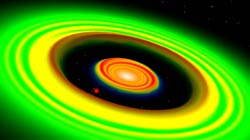
This computer model shows how a forming protoplanet (red dot) interacts with the surrounding debris and dust from a young protoplanetary disk. The florescent colors represent different densities of disk dustiness. Red is high surface density, green is the unperturbed surface density, and blue is low surface density. As the infant planet travels along its orbital path, it excites spiral density waves that propagate through the dust and debris. The planet also sweeps out the debris in its path, resulting in the gap.
Courtesy Geoffrey Bryden.
New eclipsing variable stars are usually no big deal. But when students and faculty at Wesleyan University found one in 1997 that essentially vanishes for 18 out of every 48.3 days, they knew they were onto something special. A truly huge orbiting object seemed to be blocking the star's light for more than a third of the way around its 48-day orbit. No ordinary object could fit in the space available.
On Wednesday, at a meeting in Washington, D.C., titled Scientific Frontiers in Research on Extrasolar Planets, William Herbst and graduate student Catrina Hamilton announced their exciting conclusion about what the eclipsing object actually is.
Their "winking" star, known as KH 15D, is a young, roughly solar-mass object shining at 14th magnitude from 2,400 light-years away in the Cone Nebula complex in Monoceros. Estimated to be only 3 million years old, it is young enough to have a lot of protoplanetary dust remaining around it. The only plausible eclipser, the astronomers say, is a thick, clumpy, partial arc of dust — and perhaps gravel and boulders — orbiting the star at 0.2 to 0.3 astronomical unit.

Catrina Hamilton explains 'winking' stars at the Scientific Frontiers in Research on Extrasolar Planets Conference in Washington, D.C.
Courtesy Steve Maran.
The idea that dust is blocking the starlight is supported by the color of what little light we do see during those times. It is bluer, indicating that it is scattered off dust clouds. The astronomers also conclude that the particles are larger than typical interstellar dust grains — perhaps much larger.
A partial arc orbiting so close to a young star is a big discovery. It implies that some massive object is shaping it gravitationally; otherwise the arc would dissolve into a uniform ring. But a spectroscopic study with one of the 8.2-meter reflectors of the European Southern Observatory's Very Large Telescope shows that nothing as massive as KH 15D itself can be hiding in the dust. Whatever is shaping the arc is most likely a brown dwarf or a planet.
Further support for this idea comes from detailed photometry. A whole year of nearly round-the-clock surveillance by astronomers in the U.S, Germany, Israel, and Uzbekistan shows that features in the dust disk are changing on time scales of
months. The observing campaign "is enabling us to see, for the first time, the structure and evolution of disk matter on a very fine scale," say the Wesleyan astronomers. "Since the star is quite similar to what we believe the young Sun looked like, we hope that its study will shed new light on the origins of the Earth and solar system."
Alternating eclipses differ, so Herbst now thinks that there are in fact two dust arcs circling KH 15D on opposite sides of a 96.6-day orbit. Doug Lin (University of California, Santa Cruz) interprets this is the sign of a single perturber exciting tidal patterns on opposite sides of the disk, much as happens in simulations of migrating planets embedded in protoplanetary disks.
At a press conference yesterday, Alan Boss (Carnegie Institution of Washington) expressed his excitement about the finding. The structures around KH 15D are too far away to be resolved by any existing telescope. Nevertheless, though Boss made no promises that the perturber is actually a planet, he was optimistic enough to suggest that it may prove "something of a Rosetta Stone for how planets migrate and form."
 0
0
Comments
You must be logged in to post a comment.